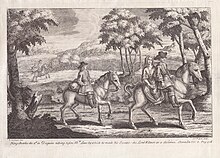

Michael Vandergucht (née Michiel van der Gucht; c. 1660 – 16 October 1725) was a Flemish engraver and painter who worked for most of his career in England. He engraved portraits, book illustrations, and architectural prints and painted portraits.
Life
Michiel van der Gucht was born in Antwerp, where he became a pupil of Frederik Bouttats the Younger. He was registered as an apprentice in the Antwerp artists' guild, the Guild of St Luke between 18 September 1672 and 18 September 1673. He is recorded in Amsterdam when, on 19 June 1682, he posted banns to marry Maria van Hogenbergh van Aerschot. He lived on the Rosengracht in Amsterdam.
He moved to England before July 1688. He trained his sons, Gerard Vandergucht (1696/97 — 1776) and Jan (John) Vandergucht (c. 1699 — c. 1730) and George Vertue and James Smith as engravers. His son Gerard became one of the leading engravers in London, following the French method of combining precise engraving with the etched tones. Gerard had 30 children of whom one, Benjamin, was a successful engraver, picture restorer and painter.
Michael Vandergucht died from gout in his house, the Golden Head in Queen Street, Bloomsbury, and was buried in the churchyard of St Giles-in-the-Fields.
Work
He engraved portraits, book illustrations, and architectural prints and painted portraits. He kept to a restrained form of engraving, without etching. His figures often appear wooden and uninspired.
He provided many of the engravings for the first complete English translation of Andrea Palladio's I quattro libri dell'architettura published in London in 1715. Most plates in the publication are reverse-copies of those in the original edition, but with measurements corrected by its editor and publisher, Giacomo Leoni.
References
- ^ Shearer West, Vandergucht family (Gucht, van der) at Grove Art Online, accessed 20 March 2022
- ^ Michael Vandergucht (1660-1725), Engraver, npg.org.uk. Accessed 2 July 2023.
- ^ Michiel van der Gucht at the Netherlands Institute for Art History
- Ph. Rombouts and Th. van Lerius (ed.), De liggeren en andere historische archieven der Antwerpsche sint Lucasgilde Volume 2, Antwerp, Julius de Koninck, 1871, pp. 421, 424 (in Dutch)
- The Architecture Of A. Palladio; In Four Books. Containing, A short Treatise of the Five Orders, and the most necessary Observations concerning all sorts of Building, As Also The different Construction of Private and Publick Houses, High-Ways, Bridges, Market-Places, Xystes, and Temples, with their Plans, Sections, and Uprights. To which are added several Notes and Observations made by Inigo Jones, never printed before. Revis'd, Design'd, and Publish'd By Giacomo Leoni, a Venetian; Architect to his most Serene Highness, the Elector Palatine. Translated from the Italian Original. at the Royal Academy
External links
 Media related to Michael Vandergucht at Wikimedia Commons
Media related to Michael Vandergucht at Wikimedia Commons